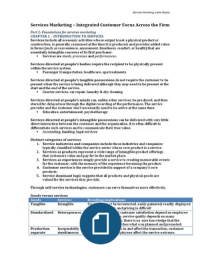Services
Marketing,
Lieke
Neijens
Services
Marketing
–
Integrated
Customer
Focus
Across
the
Firm
Part
1:
Foundations
for
services
marketing
CHAPTER
1
–
INTRODUCTION
TO
SERVICES
Services
include
all
economic
activities
whose
output
is
not
a
physical
product
or
construction,
is
generally
consumed
at
the
time
it
is
produced,
and
provides
added
value
in
forms
(such
as
convenience,
amusement,
timeliness,
comfort,
or
health)
that
are
essentially
intangible
concerns
of
its
first
purchaser.
§ Services
are
deeds,
processes
and
performances.
Services
directed
at
people’s
bodies
require
the
recipient
to
be
physically
present
within
the
service
system.
§ Passenger
transportation,
healthcare,
spa
treatments
Services
directed
at
people’s
tangible
possessions
do
not
require
the
customer
to
be
present
when
the
service
is
being
delivered
although
they
may
need
to
be
present
at
the
start
and
the
end
of
the
service.
§ Courier
services,
car
repair,
laundry
&
dry
cleaning
Services
directed
at
people’s
minds
can,
unlike
other
services,
be
produced,
and
then
stored
for
delayed
use
through
the
digital
recording
of
the
performance.
The
service
provider
and
the
customer
don’t
necessarily
need
to
be
active
at
the
same
time.
§ Education,
entertainment,
psychotherapy
Services
directed
at
people’s
intangible
possessions
can
be
delivered
with
very
little
direct
interaction
between
the
customer
and
the
organization.
It
is
often
difficult
to
differentiate
such
services
and
to
communicate
their
true
value.
§ Accounting,
banking,
legal
services
Distinct
categories
of
services
1. Service
industries
and
companies
include
those
industries
and
companies
typically
classified
within
the
service
sector
whose
core
product
is
a
service.
2. Services
as
products
represent
a
wide
range
of
intangible
product
offerings
that
customers
value
and
pay
for
in
the
market
place.
3. Services
as
experiences
simply
provide
a
service
to
creating
memorable
events
for
the
customer,
with
the
memory
of
the
experience
becoming
the
product.
4. Customer
service
is
the
service
provided
in
support
of
a
company’s
core
products.
5. Service
dominant
logic
suggests
that
all
products
and
physical
goods
are
valued
for
the
services
they
provide.
Through
self-‐service
technologies,
customers
can
serve
themselves
more
effectively.
Goods
versus
services
Goods
Services
Resulting
implications
Tangible
Intangible
Services
cannot
be
inventoried,
easily
patented,
readily
displayed
or
communicated,
and
pricing
is
difficult
Standardized
Heterogeneous
Service
delivery
and
customer
satisfaction
depend
on
employee
and
customer
actions,
service
quality
depends
on
many
uncontrollable
factors,
there
is
no
sure
knowledge
that
the
service
delivered
matches
what
was
planned
and
promoted.
Production
Inseparability
–
Customers
participate
in
and
affect
the
transaction,
customer
separate
simultaneous
affect
each
other,
employees
affect
the
service
outcome,
, Services
Marketing,
Lieke
Neijens
from
production
and
decentralization
may
be
essential,
mass
production
is
difficult.
consumption
consumption
Non-‐ Perishable
It
is
difficult
to
synchronize
supply
and
demand
with
services,
perishable
services
cannot
be
returned
or
resold.
Intangibility
is
a
key
determinant
of
whether
an
offering
is
a
service.
§ The
tangibility
spectrum
captures
this
idea.
Heterogeneity
connected
with
services
is
largely
the
result
of
human
interaction.
Inseparability:
simultaneous
production
and
consumption,
this
also
means
that
the
customer
is
present
while
the
service
is
being
produced,
and
thus
views
and
may
even
take
part
in
the
production
process.
Perishability
refers
to
the
fact
that
services
cannot
be
saved,
stored,
resold
or
returned.
Services
marketing
is
about
promises
–
promises
made
and
promises
kept
to
customers.
The
services
triangle
is
a
strategic
framework
that
shows
the
three
interlinked
groups
that
work
together
to
develop,
promote,
and
deliver
these
service
promises.
The
services
marketing
triangle
Services
marketing
mix
includes
product,
place,
promotion,
price,
and
in
addition:
people,
physical
evidence,
and
process.
People
are
all
human
actors
who
play
a
part
in
service
delivery
and
thus
influence
the
buyer’s
perceptions:
namely,
the
firm’s
personnel,
the
customer,
and
other
customers
in
the
service
environment.
Physical
evidence
is
the
environment
in
which
the
service
is
delivered
and
where
the
firm
and
customer
interact,
and
any
tangible
components
that
facilitate
performance
or
communication
of
the
service.
Process
includes
the
actual
procedures,
mechanisms,
and
flow
of
activities
by
which
the
service
is
delivered
–
the
service
delivery
and
operating
systems.
The
servuction
system
model
breaks
the
service
delivery
process
that
a
customer
receives
into
two
parts:
that
which
is
visible
to
the
customer
and
that
which
is
not.
§ The
invisible
part
is
the
process
element
§ The
visible
part
is
broken
into
the
inanimate
environment
(physical
evidence)
and
the
service
providers
of
the
individuals
(people)
who
interact
with
the
customer
during
the
service
experience.




